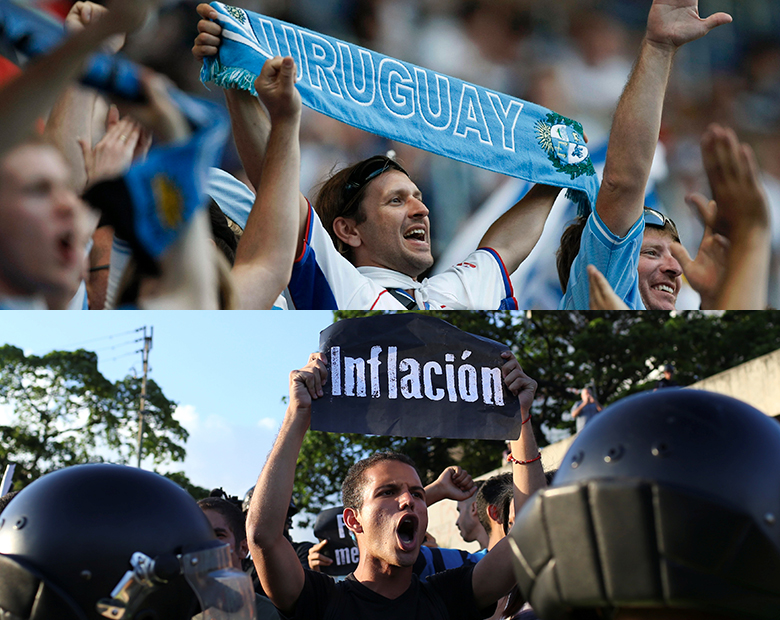Latin American economic extremes: Uruguay is flying high while Venezuela is facing a backlash
Enjoying more favourable economic conditions on the back of recovering commodity prices, LatAm’s average risk score has improved on an annual basis, bolstered by upgrades to Bolivia, Chile and Uruguay, extending long-term upward trends.
Keeping pace with other world regions, LatAm has a higher average risk score compared with 2010, and has been faring better this year than Asia, where financial volatility risks are higher overall thanks to emerging market (EM) risk aversion, and relative to the Caribbean weighed down by falling scores, notably for Barbados and Bermuda.
The gap in average Euromoney risk scores between Asia and LatAm has narrowed from 2.2 points to just 0.9 in the space of a year, with LatAm’s advantage preserved over the Middle East and North Africa – a region that was safer before the oil crisis erupted:
LatAm is not immune to shifting global sentiment, but the response of local financial markets to higher US interest rates and dollar appreciation is a heterogeneous one, say BBVA’s contributing economists.
Brazil
It is affecting Brazil greater than, say, Mexico, influenced more by the prospect of renegotiating the North American Free Trade Agreement.
Aside from basket-case Venezuela, Brazil is one of the worst performers in the region, with its risk score falling sharply since 2010.
The situation has stabilized since the political and economic crisis of 2014-2016, with capital access improved, but Brazil’s total risk score has flatlined, leaving the country lying 55th overall from 186 countries in Euromoney’s global rankings. It is a higher risk than Chile, Colombia, Mexico, Panama, Peru and Uruguay.
Brazil’s monetary policy/currency stability indicator has been downgraded this year, and political risk has increased ahead of the elections in October.
“Polarization is growing [fuelled by corruption scandals], and the old coalitions that have centred on the centre-right PSDB and centre-left Workers’ Party since democracy was reinstated in 1984 are falling apart,” says Marijke Zewuster, head of EMs at ABN Amro and survey contributor.
“Amidst this shifting landscape, the outcome of the elections is highly unpredictable.”
Public debt has grown to 75% of GDP, amid notable concerns for institutions and policymaking, and “the big question is whether the reform of Brazil’s money-guzzling pension system will get back on track after the elections”, says Zewuster.
She adds: “In the current atmosphere of widening polarization, it may be more difficult than ever to build the coalition necessary to achieve the required two-thirds majority for this reform programme.”
Beyond Brazil
In contrast, political risk has calmed in Chile, Colombia and Peru.
Those countries, along with Bolivia, have also witnessed generally improving structural risk indicators flowing from infrastructure investments.
Uruguay, pipping Honduras, is the region’s strongest performer in the survey since 2010, gaining a massive 10 points, and pushing the sovereign 19 places higher to 46th. It is now a safer option than alternative investment grades such as Bulgaria, Hungary, India, Indonesia and Thailand.
Ecuador is another growing in favour, gaining eight points since 2010, and still climbing this year thanks to a brighter outlook for economic growth and the government’s finances, as well as some, but not all, political indicators, plus improved capital access.
As for economic fortunes, LatAm is expected to produce average real-terms GDP growth this year of 1.3%, similar to 2017, according to BBVA Research, but it looks set to rise in 2019, to 2.1%, and further still in 2020.
The IMF paints a rosier picture of 1.6% growth for 2018, before climbing to 2.9% in 2019, but individual prospects vary enormously.
Argentina
Argentina’s economic growth will slow, with the possibility of recession brought on by drought undermining agricultural yields, and a currency crisis.
Its risk assessment improved in the first half of 2018 across a range of economic and political indicators, due to better capital access after securing a $50 billion stand-by arrangement from the IMF.
However, with market volatility having increased, currency depreciation leveraging inflation and business confidence waning, more anxiety is creeping in.
Overall, Argentina is still regarded as a high-risk investment on a total risk score of just 39.4 from a maximum 100 points, signalling safer opportunities in the region with stronger fundamentals.
Bolivia, for example, despite its economy slowing, will likely register 4% real-terms growth this year, the IMF predicts, while growth rates in Paraguay, Peru and Uruguay are set to accelerate.
Venezuela
Economic risk is more of a problem for some of the larger countries. They include Brazil, owing to tightened monetary conditions and a truckers’ strike; in Mexico, which is improving, but slowly; and Venezuela, the region’s highest default-risk, languishing 170th in the global rankings.
Inflation there is expected to hit a staggering one million percent by the end of this year, amid industrial strikes, shortages of food and medicines, and an electricity crisis.
The re-elected president Nicolás Maduro is to launch a new economic recovery programme, but the race is on to rescue the collapsed state oil company PDVSA with the economy now in its fifth year of steep decline.
The gap between Chile and Venezuela has widened to a record 57.8 points, highlighting the enormous disparities across the region.


 Signal2forex.com - Best Forex robots and signals
Signal2forex.com - Best Forex robots and signals




